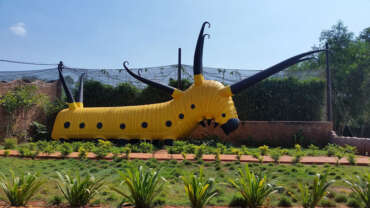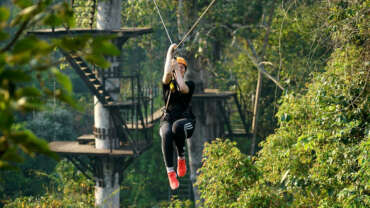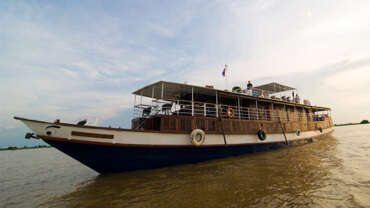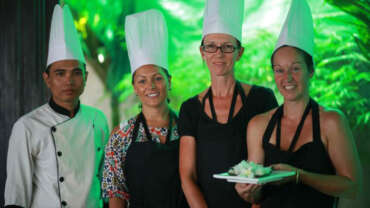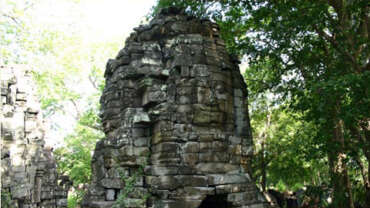Many Places, Many Experiences!
The capital of the Kingdom of Cambodia, Phnom Penh, is located at the confluence of three rivers – the Mekong, the Bassac and Tonle Sap. The city is divided into three sections – the north, an attractive residential area; the south or the French part of the city with its ministries, banks and colonial houses; and the centre or the heart with its narrow lanes, markets, foods stalls and shops.
Over the past four years, the city has undergone tremendous changes – businesses are springing up constantly and tourism is once again booming. Cambodia has one of the most liberal investment laws to further boost managed to retain its charm and character – cyclos that weave through traffic with ease, broad boulevards, old colonial buildings, parks and green spaces that reminds one of the country’s French heritage, and above all its people who always have a smile for you.
A stone’s throw away from the Tonle Sap is the royal Palace built on the site of the Banteay Kev, a citadel built in 1813. The Palace grounds contain several buildings: the Throne Room of Prasat Tevea Vinichhay which is used for the coronation of kings, official receptions and traditional ceremonies; the Chan Chhaya Pavilion which is a venue for dance performances; the king’s official residence called the Khemarin; the Napoleon Pavilion and the spectacular Silver Pagoda. This pagoda is worth exploring. It owes its name to the 5,000 silver tiles weighing 1kg each which cover the entire floor.

Rattanakiri – Cambodia Eco-ourism
Ratanakiri became a province of Kingdom of Cambodia in 1960 under King Norodom Sihanouk’s reign. Banlung is the capital city of Ratanakiri, situated in the highland, along the National Road No19 from Ou porng Moan to the Vietnam border about 200 km. ( Ou´ porng Moan-Banlung is about 120km, Banlung-Vietnam 80k.m)
Ratanakiri is situated on the north – east plateau , 636 Km from Phnom Penh. It is bordering Vietnam on the east, Laos PDR on the North, Steung Treng on the West and Mondul Kiri on the South. There are two rivers crossing the province ( Sre Pork and Sresan River )
A sparsely populated province, it is renowned for its unique natural beauty and wealth of natural resources. The physical and environmental characteristic of the province forms an impressive range including undulating hills and mountains, a level plateau, watershed lowlands, crater lakes, rivers and waterfalls. Forest cover varies from area to area, from the dense impenetrable forest in the northern reaches, which are still rich in wildlife, to the drier and sparser forest, found in the southwest. Similarly, the soil types present range from rich volcanic soil to the sandy soil found near rivers.Thus Ratanakiri province offers wonderful opportunities for Eco-tourism in Cambodia.
Kratie – Home of Freshwater Dolphins
Is a sleepy Mekong River town situated on the east bank of the mighty river.It’s very picturesque with sandbars and big islands out front and bends in the river. Unlike in many towns around Cambodia, the war years were fairly kind to the French architecture and the roads, at least in the town itself. There are some nice-looking homes of French and Khmer style scattered about, adding to the pleasant feel of the place.
The rare freshwater Irrawaddy dolphins make their home in the Mekong River, just north of Kratie. With only around fifteen to twenty remaining, they are worth a visit. Whether you are just on a trip seeing the river towns along the Mekong or taking a full circuit trip around the east and northeast, Kratie is a nice place to spend a night or two.
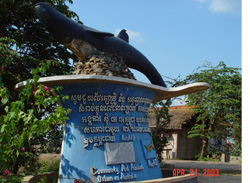
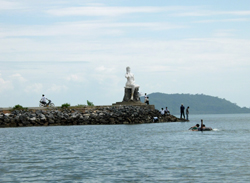
Kampot – Sea Foods
Is a small town on the Tuk Chhou River, 5km inland from the sea. Fishing and farming are the main activities; durians and melons grow in abundance. To the south end of town is a large dusty traffic circle with three hotels arrayed around it – Phnom Kieu, Phnom Kamchay and Tuk Chhou.
Each has its own restaurants; Tuk Chhou offers a seedy nightclub. Also on the circle is Prachummith Restaurant, close by is Amar Restaurant.
To the south near the river is the GPO and telecommunications building. At the north end of town, about 1.5 km away, is the Central Market, with foodstalls. All Kampot transportation is concentrated within range of the market-cycle, motors, taxis, trucks, and buses. The railway station lies farther north.
There’s zero of interest in Kampot except to walk around town and look at crumbling French-built blue-shuttered shop fronts. Previously Kampot was a stepping-stone to Bokor and Kep. You can reach Kampot by irregular plane service from Phnom Penh. It’s not advisable to get there by car. It takes about 5 hours to cover the 150 km from Phnom Penh to Kampot.
From Sihanoukville it’s 105 km to Kampot by a jumping and dirt road. The train from Phnom Penh to Kampot takes seven hours. It used to be a frequent target of the Khmer Rouge – in a 1994 ambush, three foreigners were captured by them.
Sihanoukville – Beach Resort
‘Beach town’, ‘port community’, ‘fledgling resort destination’ – all describe Sihanoukville, Cambodia’s premier beach town. Sihanoukville’s white sand beaches and warm Gulf of Thailand waters combine with a laid back, beachy atmosphere to provide a great little tropical getaway. Sihanoukville is a place to unwind by the beach, enjoy the fresh from-the-ocean seafood, take in a snorkeling or scuba trip, and generally slow-down, lay back and chill-out.
Sihanoukville has a different look and feel than most Cambodian towns. Constructed as a port city in the late 1950s, the town is much newer, more urban and cosmopolitan than most Cambodian provincial cities.
Nowadays, Sihanoukville is as much a beach town as it is a port town, catering to beach-going weekenders from Phnom Penh as well as a steadily increasing number of foreign visitors. Still, the pace of life in Sihanoukville is very relaxed.
Cows occasionally wander the main road, outside town foreign faces draw smiles and curious stares, and most of the beaches offer only beach umbrellas, thatched roofed eateries, and a growing number of restaurants, bungalows and hotels.
Sihanoukville has a more than ample supply of accommodations, including a 5-star resort complex on Sokha Beach, several mid-range places downtown and at the beaches, a few ‘upscale’ three-star hotels, and dozens of budget guesthouses, especially on Weather Station Hill (Victory Hill).
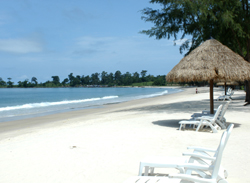
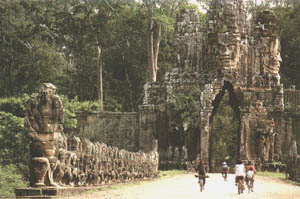
Angkor Archeological Park
This section as intended as a guide for visiting the monuments at Angkor. It can be either read in advance of a visit or afterwards to reinforce the experience, or used at the sites to enable the visitor to be an active spectator. Historical quotes from early visitors to Angkor are included where appropriate to try to capture the spirit of its past glory.
Legends and symbolism are also included whenever feasible to give the visitor additional background for a better appreciation of Angkor.
VISITING THE MONUMENTS
It is based on the amount of time the visitor has to spend at Angkor and take into consideration the roads, proximity of the temples, and favorable light conditions.
For some temples it is important to begin at the principal entrance to perceive the space and decoration as the builder intended, and entrances are indicated in the text. The monuments are oriented according to the four points of a compass which can be used as a point of reference. the temple of Angkor Wat is covered in detail in this book because of its importance, complexity and size.
Angkor provides wonderful photographic opportunities. the monuments and the surrounding jungle afford unlimited textural and lighting opportunities for composing a picture.
Clouds are common and tend to diffuse the light which is somewhat flat even though it is intense. As most of the temples face east the best lighting conditions are in the morning except for Angkor Wat where the best light is in the afternoon because it faces west. the temples surrounded by jungle such as Ta Prohm and Preah Khan can be photographed with good results when the sun is directly overhead and shining through the foliage. Just as one is never prepared for the enormous size and overwhelming beauty of Angkor, one is never ready to leave it. With photographs and visions etched in memory, one need never say good-by to Angkor, for its magic will go with you wherever fate and the gods may take you to colour your thoughts and dreams to life’s very end.




